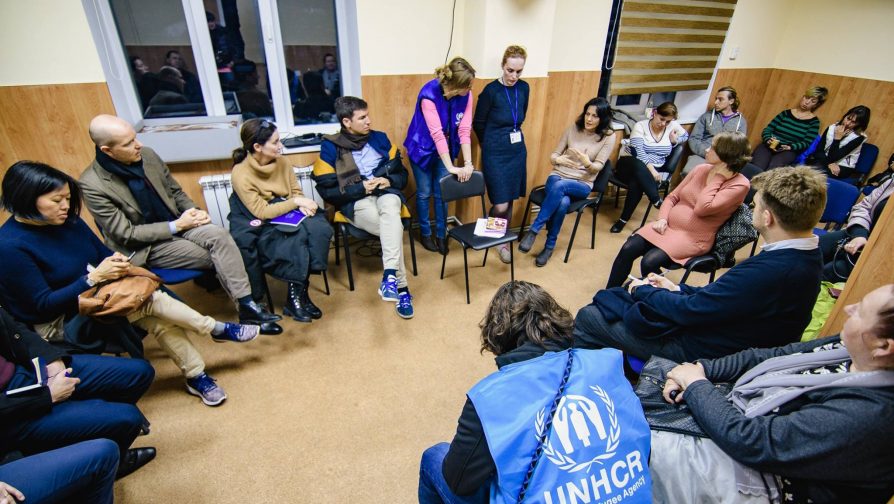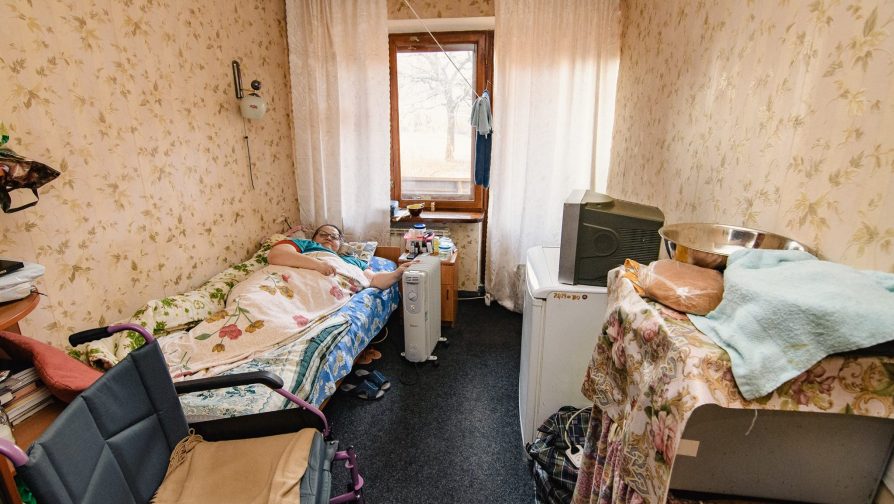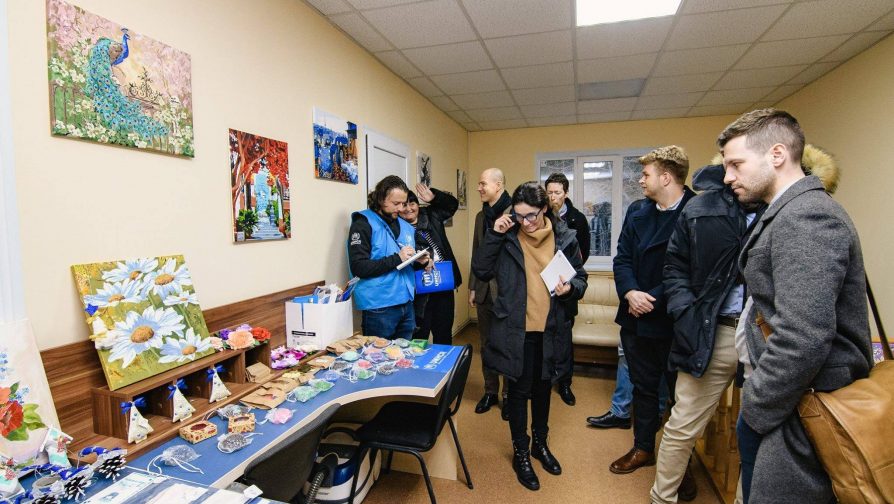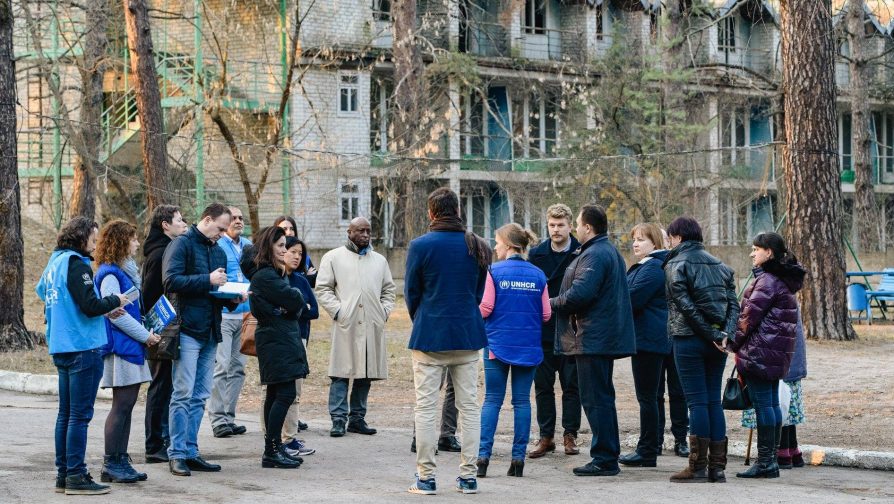Diplomats based in Kyiv visited east Ukraine together with UNHCR to witness the continuous humanitarian and protection needs near the ‘contact line’ on the government controlled-side.
On 19 and 20 March 2019, UNHCR facilitated a mission of eight diplomats to eastern Ukraine to witness the humanitarian and protection needs of conflict-affected communities and visit UNHCR and partner projects.
Upon arrival on 19 March, the delegation received an introductory briefing by UNHCR that included Protection and Security components. The delegation first visited a 2017 “Quick Impact Project” (QIP) implemented in Sloviansk by UNHCR in cooperation with GIZ (Deutsche Gesellschaft für Internationale Zusammenarbeit gmbh). The QIP consisted of the renovation of a cultural and sports centre for persons with disabilities (both displaced and non-displaced people), a good example of how humanitarian and development agencies can cooperate.

Today, the centre hosts a variety of activities for IDPs and locals, including persons with disabilities and orphans. The visit was facilitated by the Deputy Mayor of Sloviansk Local Administration who highlighted the centre’s multiple usages offering sport and cultural activities for different age groups as well as persons with disabilities.
In Sviatohirsk, the delegation visited two collective centres together with UNHCR’s NGO partner Slavic Heart: “Sviati Hory” and “Troyanda”. In “Sviati Hory” (currently hosting 219 IDPs), the delegation had a chance to meet with two IDP families. One of them was headed by Iryna, a 60-year-old displaced woman, who lives alone and is bedridden because of diabetes and a heart condition. Iryna was supported with cash-based individual protection assistance in February 2019, which she used to purchase a heater to protect herself from the freezing temperatures of the collective centre during winter. In the discussion with diplomats, Iryna shared her challenges accessing quality healthcare and the difficulties of living alone and having to fend for herself. Iryna really wants to return home, but her apartment was severely damaged by shelling leaving her with no better option that her tiny cold room in this collective centre, which has been her home during the years of conflict.


In “Troyanda”, where 126 IDPs reside, the delegation witnessed better conditions thanks to the self-mobilization of the community who advocated with the local authorities for heating and improved living conditions. UNHCR supported the “Troyanda” collective centre with a “Community Based Initiative” aimed at strengthening the IDP residents’ self advocacy. UNHCR emphasized that collective centres are not a durable solution for IDPs. The NGO Slavic Heart is frequently visited these centers and meeting with individuals with specific needs in order to provide them with individual support, such as UNHCR’s cash for protection individual assistance and/or legal support.

On 20 March, the delegation visited the Maiorsk entry-exit checkpoint (EECP) through which three million people crossed in 2018 and 453,000 in February 2019 to access social benefits/pensions and/or visit relatives. At the EECP, they received a briefing by the State Border Guard Services of Ukraine that highlighted UNCHR’s support by providing booths, computers, office equipment and body cameras for a more efficient and corruption-free processing of civilians.
UNHCR emphasized the need for stronger support to the State Emergency Service, as well as the need for the authorities to prioritize the elderly, who represent a majority of those crossing the ‘contact line’ in order not to lose access to their pension benefits. UNHCR’s NGO partner The Right to Protection (R2P) also briefed the delegation on their protection monitoring activities at the EECP. To see the results of R2P’s protection monitoring, please click here to see an interactive infographic developed jointly by UNHCR and R2P.
Finally, the delegation visited the conflict-affected village of Avdiivka adjacent to the ‘contact line’. In Avdiivka, the delegation visited a Peaceful Co-existence Project funded through UNHCR’s multi-donor programme: a special treatment centre for children with mental disabilities. The donors then visited a residential eight-story building facing the ‘contact line’ which carried fresh signs of recent shelling and is being occupied by the military.
Through a walk around the neighbourhood, the diplomats could observe recent destruction on buildings as well as UNHCR’s assistance, especially repairs with emergency shelter kits. These emergency shelter kits are distributed to conflict-affected villagers thanks to UNHCR’s partner NGO, Proliska. The NGO Proliska is present along the ‘contact line’ and provides rapid humanitarian and protection response to those affected by conflict.

During the last part of the mission, the delegation visited the homes of beneficiaries of winterization and cash for protection individual assistance. Among others, they met Valentyna and her family who live in an area that is regularly shelled. For more information on cash for protection individual assistance, click here.
In 2015, the roof and windows of their house were damaged by shelling. Valentyna’s husband is bedridden after his leg was shot by a ‘lost bullet’ as he walked in his garden and he is therefore unable to work. To complicate matters, Valentyna’s daughter has limited mobility because of a hip fracture, while her grandson suffers from cerebral palsy. As a result, Valentyna is the breadwinner of the family, although she has limited mobility on her arm because of a recent stroke.
Share on Facebook Share on Twitter